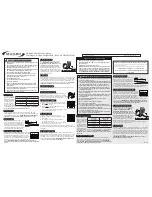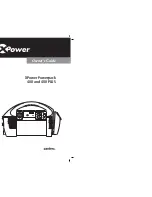
c.
b.
EDU-004
EDU-004
pag.
7/
8
pag.
2/
8
EDU-004
EDU-004
pag.
3/
8
pag.
6/
8
EDU-004.
ElectronicSoldering.
Module’spower
supply.
Thecircuit
issupplied
at
9V
DC,even
ifit
canaccept
voltagefrom
5t
o1
2V
DC.Y
ou
haveto
usea
laboratorystabilised
powersupply
likethe
CebekFE-103.
Thecircuit's
powersupply
isdone
throughinput
terminals,identified
withpositive
andnegative
symbols.R
egardingthe
powersupply
connectionyou
haveto
respectthe
indicated
polarity.For
theinstallation,
wesuggest
youto
placea
switchand
a5
0m
Afuse
onthe
positiveinput.
Required
Material.
T o
makethis
practiceit
willbe
necessary:
.-A
solderingiron
forelectronics,
a“pencil”
typeor
solderingstation.
.-Cut
pincers
.-Fixing
pincers
.-Pincers
Moreover
,i
fyou
alreadyhave
atool
tosupport
theprinted
circuitboard
and
components,you
canse
it.
EDU-004.
Electronic Soldering.
Step 3. To select components and to insert them, (
).
2nd part
Step . To verify the soldering iron temperature
4
.
Step . To clean e
5
lements.
Step . To start the soldering
6
.
according to the projected components' height.
Usually, the soldering process is started with integrated circuit and their basis, then
components with lower height like transistors, small capacitors, leds, etc….and
successively till you complete the circuit with higher components.
Concerning the manual soldering, there are several tools to help you to maintain fixed
components on the circuit till you finish the soldering, leaving free both hands. Ifyou
don't have any tool, you will be obliged to use alternative fixing methods.
Some components like resistors allow, through their opening terminals, to be turned
without falling and then to be soldered. Others components require to be obligatory
fixed to the board, for instance, using specific pincers…
The soldering process has to be start when the soldering iron reaches the maximum
operating temperature. A practical way to check it is to move closer the tin to the tip
and if it melts without problems, that means the soldering iron is ready to be used.
Before to start this process, it is highly recommended to check the board side where
components have to be soldered. For industrial circuits, containing a previous tin bath,
you only have to brush the surface to eliminate any impurity or tin wire, invisible at the
sight. For home circuit, a previous cleaning with alcohol or solvent will make easier the
soldering operation.
Regarding the soldering iron tip, before to sold each component you have to check the
its cleaning state. If you have an accumulated excess of tin or resin, you have to clean it
washing the dirty tip part with a wet sponge and with the tip as hot as possible. This
operation has to be constantly and frequently done till you finish the circuit; otherwise
it can be produced failures on the soldering or problems on the soldering process.
The soldering iron tip has to be placed on the union of two elements to solder,
allowing the heat distribution between both. You have to control the heat application;
this one has to be enough to heat both components, but not excessive, to avoid to
damage the component. If you use pincers to support the component's pin, you have
also to take in account the temperature loss due to the pincer's absorption.
When both elements are heated, without removing the soldering iron, you have to
apply the tin on the surface to solder, avoiding to touch the tip. The tin will be melted
and flow between both elements to solder, being distributed on the surface. If this
surface is important (the hole as important as the pin), the tin may have some
Bibliography.
-O
nGoogle:
Soldering|
Solderingstation.
-O
nthe
internet:www
.fadisel.com|
www.jbc.com
|
www.panavise.com/f/vises/vises_cbholders.html
EDU-004.
ElectronicSoldering.
Thesoldering
practiceincludes
aboard
composedby
10identical
circuits'auto
cutand
componentsto
assemblethem.
Seethe
circuitelectrical
drawingand
componentsmap
toeasily
foundtheir
valueand
theirlocation
onthe
circuit.
Theend-user
hasto
assembleand
tosold
these10
circuits,the
practiceof
this
repetitiveprocess
willinsure
youthe
initiationand
theimprovement
concerningthe
solderingtechnique.
Firstly,you
haveto
controlthe
rasterof
thecomponents
presenton
thecircuit,
aswell
asthe
acquisitionformat.
Forinstance,
ifthe
resistors'location
issupplied
ina
15
mm
rasteror
atthe
oppositein
10mm
(asthe
suppliedone
inthis
practice).
Itwill
benecessary
tocut
temto
asuitable
size.There
aredifferent
toolsspecially
designedfor
thisfunction,
evenif
generallythis
preparationis
manuallydone.
Cutor
standardpincers,
tinand
solderingiron
aswell
asa
wetsponge
willbe
necessarytools
tostart
thesoldering.
Asoldering
ironsupport
willbe
highly
recommendedto
avoidburns
oaccidents
dueto
alack
offixing
whenit
isuseless.
T o
cutand
removeseveral
circuits,you
haveto
slightlypress
inopposite
waysthe
circuitto
removeand
thefollowing;
thenyou
couldeasily
withdraweach
piece.
Onceinserted
onthe
circuit,each
componentprojects
adetermined
heighton
the
circuit'sbasis.
Indeed,a
diodeor
anintegrated
circuitdon't
havethe
sameheight
thana
capacitoror
aterminal.
Inorder
toavoid
anydisturb
duringthe
solderingprocess
and
touse
assemblytools,
thecomponent
insertionwon't
bedone
inanarchical
modebut
SolderingP
ractice
ElectricalDrawing
LD1
LD2
R4
R3
T2
T1
R1
R2
D1
C1
C2
1/4W
.All
Resistors
Vcc
Vcc
Vcc
R1
10K
T1
BC547
R3
10K
T2
BC547
+
C1
100uF
+
C2
100uF
LD2
5m
mle
d
R2
560
R4
560
LD1
5m
mle
d
Vcc
POWER
1
2
D1
1N4003
Green
Red
Componentsindication.
Practice
Drawings.
Step1.
T o
preparethe
material.
Step2.
T o
removethe
circuitfrom
thepanel.
Step3.
T o
selectcomponents
andto
insertthem.
Module´soperating
mode.
Oncethe
modulesupplied,
itwill
starta
constantintermittence
betweenthe
led1
and
theled
2.The
intermittencespeed
willdepend
onC1
andC2
capacitors.If
youare
usingcapacitors
withlower
capacity,the
intermittencespeed
willbe
higher .A
tthe
opposite,if
capacitorsoffer
ahigher
capacity,the
intermittencespeed
willdecrease.
Moreover
,i
fC
1and
C2have
adifferent
value,the
intermittencewill
beasynchronous.
180º
90º
raster
Components preparation and auto fixing.
a.
EDU-004.
Electronic Soldering.
Cebek educational modules included in the EDU serial offer several practices to analyse,
experiment and to learn basic knowledge on the studied theme. Nevertheless, their
function is not to make a mini-class on each theme, but to complete and to be used as
basis, as well as to allow to experiment on the theoretical theme evocated by the teacher.
For this reason, we suggest you to use modules form the EDU serial under the
supervision and the direction of a teacher.
Cebek doesn't offer a consulting service as concern the theoretical or the operating
principles concerning the theme deal with the module. It only offers a technical assistance
regarding questions and problems coming from the circuit's internal operating mode.
All Cebek modules included in the EDU serial have a warranty of 3 years as concerning
components and labour man. All damages provoked by external causes (from the circuit),
as well as wrong connections or installations or due to an operating mode no indicated
into the module's documentation won't be covered by the warranty. More over, all wrong
or incorrect handling won't be excluded from the warranty. For any claim, you have to
present the corresponding invoice.
To contact our technical department, you can send a message to
, or a
fax :Nº+34.93.432.29.95 or a mail to the following address: CEBEK, c/Quetzal, 17-21,
08014 Barcelona (SPAIN).
Warranty and Do not forget.
Rules and Identification of the EDU serial elements.
To make easier the identification and for a single rule as concern different practices and
educational Cebek modules, all common elements will answer to colour code and to a
shape.
Test Point. (TP).
It allows to connect oscilloscope's or multimeter extremities to read parameters
relating to the practice. According to its colour, it will indicate that the Test Point
(TP) is connected to the positive or to the negative of the circuit, as well as reads
concerning current, voltage, load, etc….
Jumper.
circuit
Red
Conmutator / Switch.
Power supply
Current
Voltage
Red
Blue
Yellow
Logical
TP. Tension
Yellow
TP.
circuit
Black
TP.
TP. Courant
Blue
TP Without current or TP AC.
White
Green
It allows to close or open a signal or an electrical circuit
According to the colour of the switch, you can control the voltage, the current
Beforeto
start...
Beforeto
starta
practice,it
isvery
importantto
carefullyread
itsinstruction
manualas
wellas
correspondingindications.
Y ou
haveto
docorrectly
connectionsin
indicatedcontact
points,otherwise
measures
dependingon
theseconnections
willbe
confusesor
wrong.
Donot
makeconnections
notindicated
inthe
instructionmanual
toavoid
todamage
thecircuit.
Ifthe
Ledof
thepower
supply“PWR
”doesn't
lighton
orif
itsfunction
suddenlystops,
youhave
toquickly
disconnectthe
powersupply
forthe
deviceand
checkthere
isany
short-circuitas
wellas
thefuse's
status.
Evenif
describedpractices
canbe
donefollowing
instructionmanual,
werecommend
youto
useit
underthe
supervisionof
ateacher
whocan
adviseand
bringyou
asupport
(anhelp)
concerningdescribed
concepts.
Inthe
circuit,each
practicewill
bedelimited
bya
rectanglewith
thecorresponding
number .One
orseveral
experiment(s)can
bereported
andreferenced
tothis
practice.


























